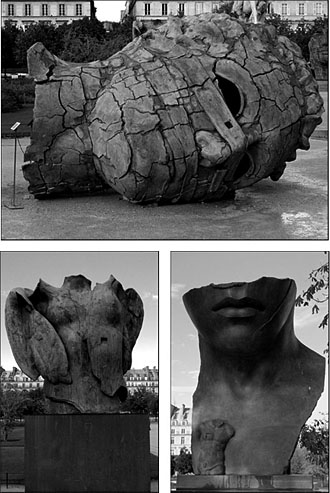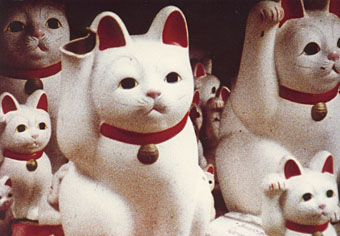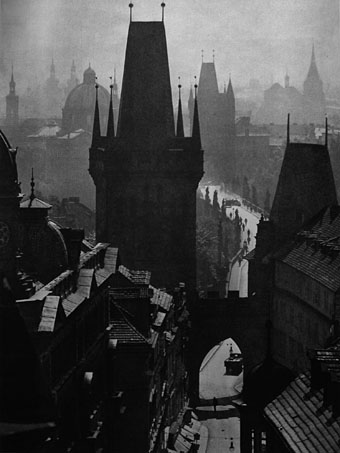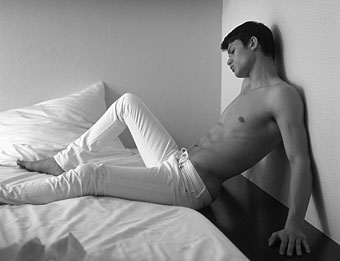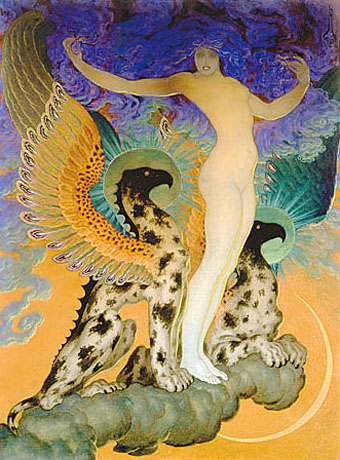Great photo galleries of the artist’s work from a
Tuilleries exhibition here and on three pages following.
Month: September 2006
Sans Soleil
Chris Marker might be considered the Borges of cinema if that designation didn’t seem limiting, with its implication that literature is superior to cinema, that filmmakers only receive true qualification as artists through comparison to more venerable creators, and so on. Marker, then, is Marker, although who Marker is remains obscure, as this article notes:
Some say his father was an American soldier, others that he (Marker) was a paratrooper in the Second World War. Still others, that he comes to us from an alien planet. Or the future. Throughout his career, he has rarely been interviewed, and even more rarely photographed. It is said that he responds to requests for his photograph with a picture of a cat – his favorite animal.
The possibility that he comes from the future is a compelling conceit when his most famous work, La Jetée, is a very subtle film about time travel (later remade with a huge budget and no subtlety at all by Terry Gilliam as Twelve Monkeys). JG Ballard and others have enthused about La Jetée for years but my favourite Marker film remains Sans Soleil, a meditation on time, memory, travel and culture, blending documentary images with a semi-fictional (?) voice-over narrative that resists easy summary. In this respect it parallels some of Borges’ essays or “ficciones”; like many of Borges’ best works it manages to be both personal and universal, drawing connections which seem obvious until you realise that no one has pointed them out in quite that way before. An equally fascinating companion to Sans Soleil is Marker’s CD-ROM, Immemory, a Mac-only release that’s already out-of-date in software terms (and since Classic stopped working on my Mac even I can’t use it for the time being).
This site presents a critical reading of Sans Soleil as a rather disjointed web experience. And you can read the text of the film here. Needless to say, none of these are very satisfying at all without the accompaniment of Marker’s images.
Karel Plicka’s views of Prague
Bridge Street, from Prague in Pictures (1940).
A shame there isn’t more of Plicka’s atmospheric photography on the web, his views of Prague present the city the way we usually imagine it from the stories of Kafka and Gustav Meyrinck. This site features a very small selection from the 220 plates that comprise his Prague in Pictures book. Taschen have published a collection of Atget’s famous photographs of Paris; the “Ansel Adams of Czechoslovakia” is overdue for a similar reappraisal.
Previously on { feuilleton }
• Giant mantis invades Prague
• Atget’s Paris
• Barta’s Golem
Eugen Bauder
Eugen Bauder photographed by Jean-Philippe Guillemain.
The art of Nicholas Kalmakoff, 1873–1955
Astarte (1926).
Kalmakoff’s beautiful paintings turn up most often (if at all) in collections of Symbolist art although most of his work comes after the Symbolist period which was pretty much killed off by the revelations of Cubism. Like Harry Clarke, Kalmakoff is one of those artists who evidently felt that the aesthetics of the 1890s required further exploration; like Clarke there’s also some interesting occult illustration going on. Unlike Clarke (whose work appeared in lavish illustrated books and stained glass window designs) he had to contend with an art world that had little time for imagination unless it was presented in a Surrealist package. Kalmakoff’s fascinating story is detailed here and there are three galleries of his paintings here.
Previously on { feuilleton }
• Austin Osman Spare

